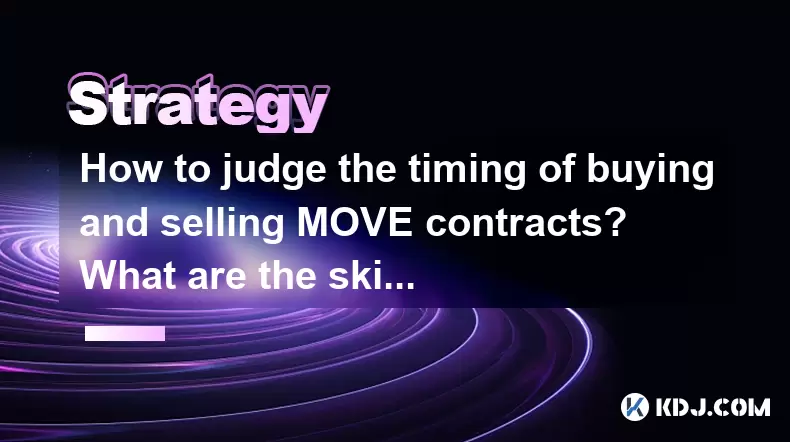-
 bitcoin
bitcoin $123963.239194 USD
1.37% -
 ethereum
ethereum $4529.082464 USD
1.07% -
 xrp
xrp $2.983640 USD
0.71% -
 tether
tether $1.000287 USD
0.02% -
 bnb
bnb $1179.874393 USD
2.99% -
 solana
solana $230.633678 USD
1.55% -
 usd-coin
usd-coin $0.999835 USD
0.03% -
 dogecoin
dogecoin $0.254240 USD
1.34% -
 tron
tron $0.341176 USD
0.15% -
 cardano
cardano $0.842285 USD
0.52% -
 hyperliquid
hyperliquid $48.537896 USD
-0.86% -
 chainlink
chainlink $21.863092 USD
-0.84% -
 ethena-usde
ethena-usde $0.999743 USD
-0.07% -
 sui
sui $3.579561 USD
-0.18% -
 stellar
stellar $0.403418 USD
2.67%
How to judge the timing of buying and selling MOVE contracts? What are the skills for short-term trading?
To time MOVE contract trades, analyze market trends, use volatility indicators like Bollinger Bands, and implement strategies like scalping during high volatility periods.
May 20, 2025 at 08:22 pm

Understanding MOVE Contracts
MOVE contracts are a type of derivative product in the cryptocurrency market, often used for short-term trading. These contracts derive their value from the volatility of the underlying asset, making them particularly attractive for traders looking to capitalize on market fluctuations. To effectively judge the timing of buying and selling MOVE contracts, one must have a deep understanding of market trends, volatility indicators, and trading strategies.
Analyzing Market Trends
Before engaging in the trading of MOVE contracts, it's crucial to analyze market trends. This involves studying the historical data of the underlying asset to identify patterns that could signal potential volatility. Traders often use tools like moving averages, trend lines, and chart patterns to forecast future movements. For instance, a rising trend line might suggest increasing volatility, which could be an opportune time to buy MOVE contracts.
To analyze market trends effectively, consider the following steps:
- Gather historical data: Use reliable sources to collect price data of the underlying asset over a significant period.
- Apply technical analysis: Utilize tools such as moving averages, RSI (Relative Strength Index), and MACD (Moving Average Convergence Divergence) to identify trends.
- Monitor news and events: Keep an eye on news and events that could impact the market, as they can lead to sudden changes in volatility.
Utilizing Volatility Indicators
Volatility indicators are essential for timing the purchase and sale of MOVE contracts. These indicators help traders gauge the level of market volatility, which directly affects the value of MOVE contracts. Common volatility indicators include the Bollinger Bands, Average True Range (ATR), and the Volatility Index (VIX). A higher reading on these indicators often suggests increased volatility, which could be a signal to buy MOVE contracts.
Here's how to use volatility indicators effectively:
- Set up your trading platform: Ensure your trading platform supports the volatility indicators you wish to use.
- Monitor indicator readings: Regularly check the readings of your chosen indicators to stay updated on market volatility.
- Combine indicators for confirmation: Use multiple indicators to confirm your analysis, reducing the risk of false signals.
Implementing Trading Strategies
Successful trading of MOVE contracts requires the implementation of effective trading strategies. These strategies can range from simple to complex, depending on the trader's experience and risk tolerance. Some common strategies include scalping, swing trading, and day trading. Each strategy has its own set of rules and timing considerations.
For instance, scalping involves making numerous trades within a short period to profit from small price movements. To execute this strategy effectively:
- Identify liquid markets: Choose markets with high trading volumes to ensure quick execution of trades.
- Set tight stop-losses: Use stop-loss orders to limit potential losses on each trade.
- Monitor short-term charts: Focus on minute-to-minute or even second-to-second price movements to spot trading opportunities.
Skills for Short-Term Trading
Short-term trading of MOVE contracts demands a unique set of skills. Technical analysis is paramount, as it allows traders to identify entry and exit points with precision. Additionally, risk management is crucial to protect against significant losses. Traders must also develop emotional discipline to avoid making impulsive decisions based on market fluctuations.
To enhance your skills for short-term trading:
- Master technical analysis: Continuously learn and practice using technical indicators to improve your ability to predict market movements.
- Implement risk management techniques: Use stop-loss orders, diversify your portfolio, and only risk what you can afford to lose.
- Develop emotional discipline: Create a trading plan and stick to it, avoiding emotional reactions to market changes.
Practical Tips for Timing Trades
Timing the buying and selling of MOVE contracts can be challenging, but certain practical tips can improve your success rate. One such tip is to trade during high volatility periods, as MOVE contracts are more likely to yield profits during these times. Additionally, use real-time data to make informed decisions quickly.
To apply these tips effectively:
- Identify high volatility periods: Use volatility indicators and market news to pinpoint times when the market is likely to experience significant fluctuations.
- Set up real-time alerts: Configure your trading platform to send alerts when specific market conditions are met, allowing you to act swiftly.
- Practice with a demo account: Before risking real money, practice trading MOVE contracts using a demo account to refine your timing skills.
Frequently Asked Questions
Q: How can I tell if a MOVE contract is overvalued or undervalued?A: To determine if a MOVE contract is overvalued or undervalued, compare its current price to its historical volatility and the volatility of the underlying asset. If the contract's price is significantly higher than expected based on these factors, it may be overvalued. Conversely, if it's lower, it could be undervalued. Additionally, use fundamental analysis to assess market conditions that could affect volatility.
Q: What are the risks associated with trading MOVE contracts?A: Trading MOVE contracts carries several risks, including market risk, where the value of the contract can fluctuate due to changes in the underlying asset's volatility. There's also liquidity risk, as some MOVE contracts may not be easily tradable. Additionally, leverage risk is a concern, as traders often use leverage to amplify returns, which can also amplify losses.
Q: How can I improve my accuracy in predicting market volatility?A: Improving accuracy in predicting market volatility involves a combination of technical and fundamental analysis. Regularly study historical volatility data, use a variety of volatility indicators, and stay informed about market news and events that could impact volatility. Additionally, practice with a demo account to refine your analysis skills without risking real money.
Q: Are there any specific tools or software recommended for trading MOVE contracts?A: Several tools and software can aid in trading MOVE contracts. Popular choices include trading platforms like MetaTrader 4 or 5, which offer a range of technical indicators and charting tools. Additionally, specialized volatility analysis software such as VolatilityTrader or TradeStation can provide advanced features for monitoring and predicting market volatility.
Disclaimer:info@kdj.com
The information provided is not trading advice. kdj.com does not assume any responsibility for any investments made based on the information provided in this article. Cryptocurrencies are highly volatile and it is highly recommended that you invest with caution after thorough research!
If you believe that the content used on this website infringes your copyright, please contact us immediately (info@kdj.com) and we will delete it promptly.
- BlockDAG, DOGE, HYPE Sponsorship: Crypto Trends Shaping 2025
- 2025-10-01 00:25:13
- Deutsche Börse and Circle: A StableCoin Adoption Powerhouse in Europe
- 2025-10-01 00:25:13
- BlockDAG's Presale Buzz: Is It the Crypto to Watch in October 2025?
- 2025-10-01 00:30:13
- Bitcoin, Crypto, and IQ: When Genius Meets Digital Gold?
- 2025-10-01 00:30:13
- Stablecoins, American Innovation, and Wallet Tokens: The Next Frontier
- 2025-10-01 00:35:12
- NBU, Coins, and Crypto in Ukraine: A New Yorker's Take
- 2025-10-01 00:45:14
Related knowledge

Practical parameter settings for a Bitcoin multi-timeframe moving average system
Sep 18,2025 at 10:54pm
Optimizing Timeframe Combinations for Bitcoin Trading1. Selecting appropriate timeframes is crucial when building a multi-timeframe moving average sys...

How can I filter out false breakouts in Dogecoin high-frequency trading?
Sep 22,2025 at 01:00am
Understanding False Breakouts in Dogecoin Trading1. A false breakout occurs when Dogecoin's price appears to move beyond a defined support or resistan...

Techniques for identifying tops and bottoms in the Bitcoin on-chain NVT model
Sep 20,2025 at 07:54pm
Understanding the NVT Model in Bitcoin Analysis1. The Network Value to Transactions (NVT) ratio is often described as the 'P/E ratio' of the cryptocur...

What does the surge in open interest in Bitcoincoin futures mean?
Sep 20,2025 at 11:18pm
Understanding the Surge in Dogecoin Futures Open Interest1. A surge in open interest within Dogecoin futures indicates a growing number of active cont...

How can I use the Ethereum USDT premium to gauge market sentiment?
Sep 18,2025 at 11:55pm
Understanding the Ethereum USDT Premium1. The Ethereum USDT premium refers to the price difference between USDT (Tether) traded on Ethereum-based plat...

What should I do if Ethereum staking yields decline?
Sep 20,2025 at 06:18am
Understanding the Causes Behind Declining Ethereum Staking Yields1. The Ethereum network transitioned to a proof-of-stake consensus mechanism with the...

Practical parameter settings for a Bitcoin multi-timeframe moving average system
Sep 18,2025 at 10:54pm
Optimizing Timeframe Combinations for Bitcoin Trading1. Selecting appropriate timeframes is crucial when building a multi-timeframe moving average sys...

How can I filter out false breakouts in Dogecoin high-frequency trading?
Sep 22,2025 at 01:00am
Understanding False Breakouts in Dogecoin Trading1. A false breakout occurs when Dogecoin's price appears to move beyond a defined support or resistan...

Techniques for identifying tops and bottoms in the Bitcoin on-chain NVT model
Sep 20,2025 at 07:54pm
Understanding the NVT Model in Bitcoin Analysis1. The Network Value to Transactions (NVT) ratio is often described as the 'P/E ratio' of the cryptocur...

What does the surge in open interest in Bitcoincoin futures mean?
Sep 20,2025 at 11:18pm
Understanding the Surge in Dogecoin Futures Open Interest1. A surge in open interest within Dogecoin futures indicates a growing number of active cont...

How can I use the Ethereum USDT premium to gauge market sentiment?
Sep 18,2025 at 11:55pm
Understanding the Ethereum USDT Premium1. The Ethereum USDT premium refers to the price difference between USDT (Tether) traded on Ethereum-based plat...

What should I do if Ethereum staking yields decline?
Sep 20,2025 at 06:18am
Understanding the Causes Behind Declining Ethereum Staking Yields1. The Ethereum network transitioned to a proof-of-stake consensus mechanism with the...
See all articles










































































